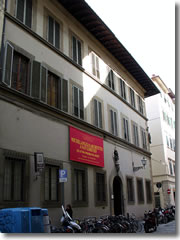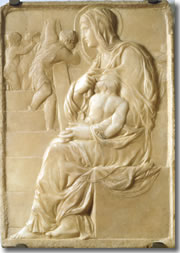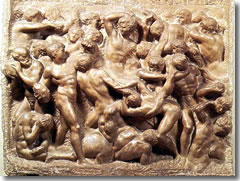
Casa Buonarotti. (Photo by G.dallorto)First thing you need to know: only die-hard Michelangelo fans or folks with plenty of time on their hands need bother with this one.
Yes, this house was bought in 1508 by the (arguably) greatest Renaissance artist of all time. However, Michelangelo never actually lived here—though he did leave it to his nephew and only heir, Leonardo Buonarotti.
And yes, the rooms do contain a few of Michelangelo Buonarotti's earliest attempts at sculpture. However, while they are fascinating in their own right, and an intriguing window into the portrait of the artist as a young man, these sculptures are not, with all due respect, The David.

Michelangelo's Madonna of the Stairs (c. 1490) in the Casa Buonarotti.These early Michelangelos are technically proficient, and offer a glimmer of the talent to come, but are otherwise the kind of largely derivative works you'd expect from a very young student.
There's a Madonna della Scala (Madonna of the Steps) (carved at age 15 or 16) that was inspired by Donatello's schiacciato super-low relief technique.
The squirming mass of bodies, Roman sarcophagus–style, of a Battle relief (carved at age 17) is based on the reliefs decorating Roman sarcophagi and shows the clear influence of Michelangelo's own sculpture tutor Giovanni di Bertoldo, himself a Donatello protégé.
The works are important largely for the mere fact that they encouraged the young artist to keep at it—and impressed his teachers, tutors, and eventual patrons enough to keep him encouraged and keep that hammer and chisel in his hands.

Michelangelo's Battle Scene (c. 1492), sometimes called La Battaglia dei Centauri, or "Battle of the Centaurs," in the Casa Buonarotti.Also by the hand of Michelangelo is a more mature work, a clay model of a torso for a river god statue that never got carved, plus a slight little Christ on the Cross carved of wood that art historians have, ever since it was discovered in Santo Spirito in 1963, had a roaring good time arguing over whether it is a long-lost early Michelangelo or a mid-16th century work by an imitator.
Michelangelo was not just a sculptor, of course, and the foundation that owns this house also rotates onto display, a half-dozen at a time, some of its drawings by Michelangelo.
There is also art created by the descendents of Leonardo Buonarotti (let us just say that the gene for artistic genius did not, apparently, get passed along), plus piles of derivative works created by a variety of imitators and admirers, and a fine little collection of antiquities collected by Leonardo's son, Michelangelo the Younger.
One other curiosity: the current structure was actually originally three neighboring houses that were linked into a single residence by Leonardo—based on plans drawn up by Michelangelo himself. Leonardo's son, also named Michelangelo, was the first to turn the home into a gallery dedicated to his namesake and famous great-uncle in 1612.
Sadly, this most direct line of Michelangelo descendents (the artist himself—who was almost certainly gay—never married or had kids) petered out in 1858, but not before the last in the line created the modern museum and left it all to the foundation that runs it to this day.
Via Ghibellina 70
tel. +39-055-241-752
www.casabuonarroti.it
Nov-Feb: Wed–Mon 10am–4pm
Mar-Oct: Wed–Mon 10am–5pm
€6.50
With Firenze Card: Free
Bus: C2, C3; 14, 23
Hop-on/hop-off: Teatreo Verdi (A)
Planning your day: Expect to spend no more than 30 minutes here, honestly. Maybe 45.
For just €2 more, you can get a combined ticket that also gets in you into the nearby Santa Croce church, making this a nice side-trip for Michelangelo fans paying homage to the great artist's tomb.
Take a guided tour of Casa Buonarotti with one of our partners:
Share this page
Search ReidsItaly.com
Nov-Feb: Wed–Mon 10am–4pm
Mar-Oct: Wed–Mon 10am–5pm
€6.50
With Firenze Card: Free
Bus: C2, C3; 14, 23
Hop-on/hop-off: Teatreo Verdi (A)